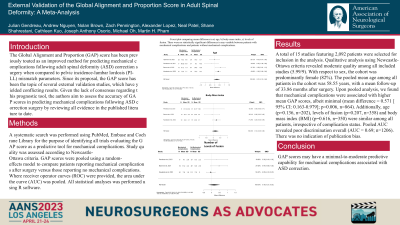External Validation of the Global Alignment and Proportion Score in Adult Spinal Deformity: A Meta-Analysis
External Validation of the Global Alignment and Proportion Score in Adult Spinal Deformity: A Meta-analysis
Friday, April 21, 2023


Nolan J. Brown, MBA
Junior Specialist
UC Irvine Department of Neurosurgery
Santa Clarita, California, United States
ePoster Presenter(s)
Introduction: The Global Alignment and Proportion (GAP) score has been previously introduced as an improved method for predicting mechanical complications following adult spinal deformity (ASD) correction surgery. Since its proposal, the GAP score has been the topic of several external validation studies, which have yielded conflicting results. Given the lack of consensus regarding this prognostic tool, the authors aim to assess the accuracy of GAP scores in predicting mechanical complications following ASD correction surgery by reviewing all evidence in the published literature.
Methods: systematic search was performed using PubMed, Embase and Cochrane Library for the purpose of identifying all trials evaluating the GAP score as a predictive tool for mechanical complications. GAP scores were pooled using a random-effects model to compare patients reporting mechanical complications after surgery versus those reporting no mechanical complications. Where receiver operator curves (ROC) were provided, the area under the curve (AUC) was pooled. All statistical analyses were performed using R software.
Results: A total of 15 studies featuring 2,092 patients were selected for inclusion in the analysis. Qualitative analysis using Newcastle-Ottawa criteria revealed moderate quality among all included studies (5.99/9). With respect to sex, the cohort was predominantly female (82%). The pooled mean age among all patients in the cohort was 58.55 years, with a mean follow-up of 33.86 months after surgery. Upon pooled analysis, we found that mechanical complications were associated with higher mean GAP scores, albeit minimal (mean difference = 0.571 [ 95% CI: 0.163-0.979]; p=0.006, n=864). Additionally, age (p=0.136, n=202), levels of fusion (p=0.207, n=358) and body mass index (BMI) (p=0.616, n=350) were similar among all patients, irrespective of complication status. Pooled AUC revealed poor discrimination overall (AUC = 0.69; n=1206). There was no indication of publication bias.
Conclusion : GAP scores may have minimal-to-moderate predictive capability for mechanical complications associated with ASD correction.
Methods: systematic search was performed using PubMed, Embase and Cochrane Library for the purpose of identifying all trials evaluating the GAP score as a predictive tool for mechanical complications. GAP scores were pooled using a random-effects model to compare patients reporting mechanical complications after surgery versus those reporting no mechanical complications. Where receiver operator curves (ROC) were provided, the area under the curve (AUC) was pooled. All statistical analyses were performed using R software.
Results: A total of 15 studies featuring 2,092 patients were selected for inclusion in the analysis. Qualitative analysis using Newcastle-Ottawa criteria revealed moderate quality among all included studies (5.99/9). With respect to sex, the cohort was predominantly female (82%). The pooled mean age among all patients in the cohort was 58.55 years, with a mean follow-up of 33.86 months after surgery. Upon pooled analysis, we found that mechanical complications were associated with higher mean GAP scores, albeit minimal (mean difference = 0.571 [ 95% CI: 0.163-0.979]; p=0.006, n=864). Additionally, age (p=0.136, n=202), levels of fusion (p=0.207, n=358) and body mass index (BMI) (p=0.616, n=350) were similar among all patients, irrespective of complication status. Pooled AUC revealed poor discrimination overall (AUC = 0.69; n=1206). There was no indication of publication bias.
Conclusion : GAP scores may have minimal-to-moderate predictive capability for mechanical complications associated with ASD correction.
